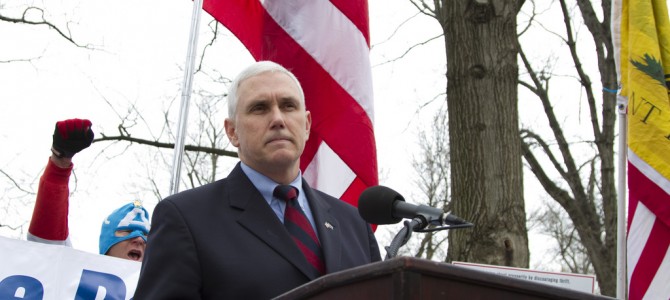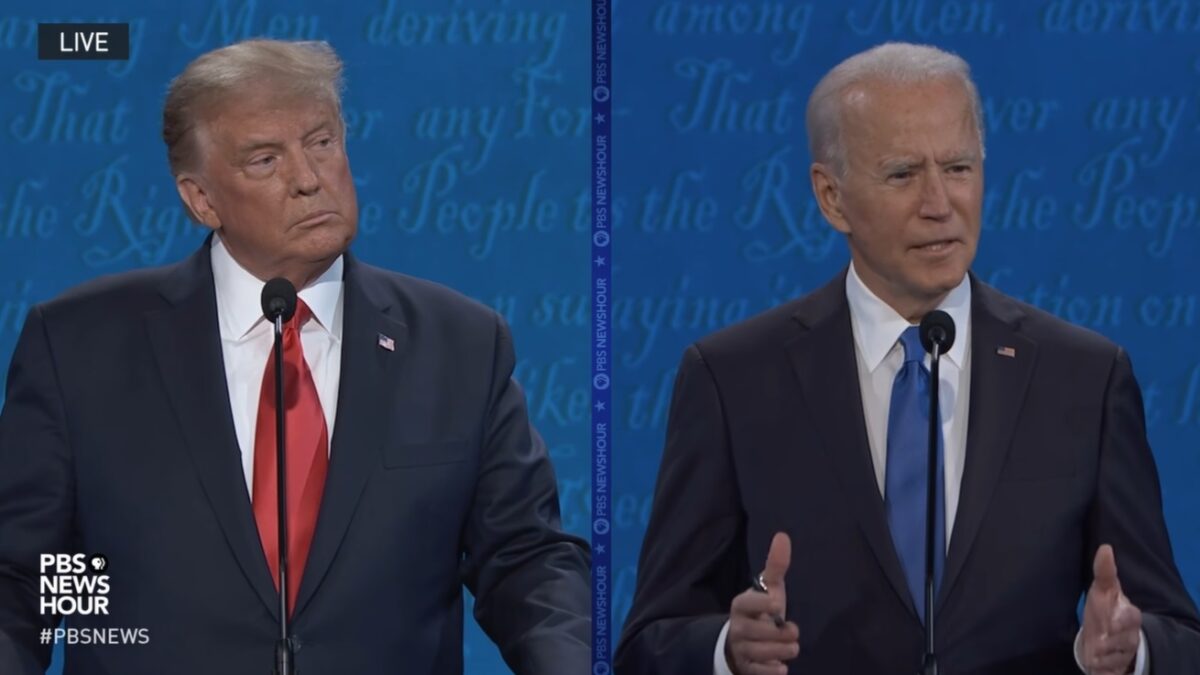
Indiana Gov. Mike Pence would like to ride into the presidency as he has his governorship: On the coattails of his predecessor, former Gov. Mitch Daniels. Unlike his years in Congress, Pence’s governorship has been largely marked, not by forging crucial and substantive policies that rein in the administrative state and advance the cause of liberty, but by a refusal to make waves. In our current climate, that means governing as a technocratic Progressive.
So while treating Hoosiers to essentially the stable status quo Daniels earned making tough and politically risky decisions, Pence has been traveling the country, proclaiming his conservative chops and hoping to increase his visibility through marketing rather than liberty-rejuvenating policy. For one, Pence is set to join Texas Gov. Rick Perry in headlining Americans for Prosperity’s Defending the American Dream Summit, the nation’s second-largest annual conservative gathering (the other being CPAC). AFP, of course, has long staunchly opposed Obamacare, and typically targets government spending and crony capitalism. As such, it runs to the right of most Republicans, which now apparently includes Pence.
Pence’s record as governor marks a turn from his well-regarded tenure as U.S. Representative. Rather than governing as a conservative, he has governed as a Republican. That’s not because he has to constantly compromise with a strong opposition. In this, Pence’s first year as governor, Republicans even have supermajority control and can do essentially anything they want. Daniels had to negotiate with Democrats. They even walked out on him and precluded state business when they were in the minority, and he stood firm like Wisconsin’s Gov. Scott Walker. But Pence is proving to be no Daniels. Instead of showing how conservatives can cut bureaucracy and expand liberty when given the berth—and certainly Democrats take a mile to do the opposite if given an inch—Pence has instead been indicating he’s been in Washington too long, and absorbed its comfort with a well-padded government fed by an attenuating citizenry.
Here are four prominent policy decisions Pence has made as governor where, in a clear choice between managerial Progressivism and robust self-government, he chose the administrative state.
1. Government-Managed Healthcare
Between them, healthcare and education are the most government-embedded sectors of our already heavily interventionist economy, and the two set to drive our economy for the foreseeable future. As Arnold Kling and Nick Schulz put it in National Affairs a few years ago, ” [I]t will simply not be possible to maintain a genuine free market—or a thriving, innovative, growing economy—if our education and health sectors are controlled by the government.” So how a leader treats these policy areas is a crucial indicator of his governing philosophy. Will he perpetuate and reinforce the socialist tendencies of these sectors, or can he reverse them?
Pence’s answer to that, with his recent Medicaid expansion, seems to be, “No.” Faced with, yes, a Gordian knot of largely federal making, Pence decided to accept and expand government-managed healthcare rather than return to individuals the control over their most personal decisions that we all deserve. In so doing, Pence likely saddled us Hoosiers with millions in cost overruns and increased healthcare welfare, besides expanding substandard care for the poor people shoveled into this government monstrosity. Ben Domenech “asked Pence whether he really thought it was a wise policy, a conservative policy, to expand a welfare entitlement to subsidize able-bodied childless adults by taking money from hardworking taxpayers in other states—he said of course it is, or he wouldn’t have proposed it. So there’s that.”
Since Obamacare and alternatives to it are obviously again going to dominate the 2016 campaign, Pence squandered an opportunity to demonstrate political courage, a preference for personal responsibility, antipathy to bigger government, and regard for the hardworking families who actually do pay taxes (and whose kids will pay off debt incurred today—if we don’t encourage them to migrate somewhere else to avoid it). While this is obviously a tough decision for any governor, both Perry and Louisiana Gov. Bobby Jindal, among others, have managed to make better, and actually conservative, policy. Pence had better options. He decided not to take them. But that didn’t stop him from going back to DC to tell everyone (especially 2016 kingmakers) his bad decision was great. Of course.
2. Common Core-Style Education
Republican voters are strongly anti-Common Core, and 2016 contenders have gotten that message loud and clear. Just ask Jindal, who quickly and recently reversed his previous support for the initiative nationalizing U.S. education through federally controlled tests. Common Core is a litmus test for education philosophy, because it divides those who support the centrally-managed (and therefore poor-performing) status quo from those who realize it’s time to return power to the people.
The initiative arose from a bunch of DC-based, federally funded, special-interest groups who (always) think they know what’s best for everyone else’s kids. They created a set of mediocre-quality curriculum and testing regulations that, sight unseen, nearly every state agreed to live under in exchange for a shot at federal cash. George Will calls Common Core “a thin end of an enormous wedge of federal power that will be wielded for the constant progressive purpose of concentrating power in Washington so that it can impose continental solutions to problems nationwide.”
Because Indiana had one of the best sets of curriculum and testing regulations in the nation before trashing them for Common Core, the mothers whose kids started to encounter its inane math raised a ruckus over the degraded curriculum. It took two years, but in 2013 and again in 2014, they got the state legislature to yank Common Core and task the state board of education with replacing it. During the legislative battles, Pence sat on the sidelines and dodged questions about his stance on the repeal bill, when the grassroots coalition against it was desperate for political support. Pence ultimately signed a repeal bill, but did nothing to help it across the finish line. He let his citizens— moms, kids, dads, and grandparents—run themselves ragged generating the political leadership he could have executed much more easily on their behalf.
When the state department of education published a Common Core replacement that essentially paraphrased Common Core but with even more confusing language and lower academic standards, grassroots activists, a lone conservative member of the education board Pence controls, and nationally recognized content experts Pence had requested comments from explained the document’s many shameful failings in face-to-face meetings and personal correspondence with Pence and his education staff. He rebuffed them all, siding with a state education establishment that had discredited itself by releasing education mandates of laughable quality, and which no independent analyst gave a good review.
After stomping all over the earnest desires for freedom and good policy from his state’s most earnest citizens and dedicated parents, Pence then congratulated himself because “we drew on educators, we drew on citizens, we drew on parents and developed standards that meet the needs of our people,” and called it a day. Then Pence had the temerity to go on Fox and boast he had gotten rid of Common Core and talk about a potential 2016 run, when what he had really done was switch the brand names on Hoosier kids’ mental chickenfeed. What a leader.
3. A Managed Economy
Besides a penchant for botching big policies that reach his desk, the policies Pence selected as priorities are also straight from the managerial Progressive playbook. The first, Pence’s big gubernatorial plank, is a managed economy.
He doesn’t call it that, of course—he focuses on jobs and vocational training, both good and necessary in the abstract. But his manner of attempting to improve these was not to get government out of people’s way, but put government front and center of education and the economy, where it already sits and slobbers as it snarfs down children’s futures, freedom, and innovation. Pence’s big solution to the state’s economic doldrums consists of creating several committees of unelected bureaucrats, most of whom he appoints. It’s exciting to centralize power when you’re the guy amassing much of it, eh?
Not content to trust the spontaneous order and lack of coercion within the free market, despite its excellent track record and the rather horrifying track record of all the alternatives, Pence wants to further inject government-directed “order” into the education and workforce non-markets to solve the problems created by previous impositions of government-directed “order” into the education and workforce non-markets. The way to do this, Pence claims, is to “align education and the workforce” using databases that track citizens from at least toddlerhood through their entire careers and steer these citizens in directions that meet “the needs of Indiana’s regional economies” (see the masterplan, courtesy of an eagle-eyed fellow Hoosier). People apparently can’t be trusted to do what is good for them, so they need government to manage them using databases and “strategic” grants that undoubtedly will never go to campaign donors and golf buddies.
As an example of the idiocy inside such plans, consider that this one emphasizes the need to shovel more people into post-high school training and college (apparently the two are now synonymous): “Over the next decade, estimates suggest that more than 60 percent of jobs in Indiana will require some form of postsecondary education,” yet a few pages later, “Strategic Imperative 5” is to “Address the shortage of employment opportunities for individuals with a bachelor’s degree or greater educational attainment.” Ok, apparently we need lots more people to have a shortage of employment opportunities. Check.
Pence’s economic planning committee also wants to pay off the college costs of graduates who got “degrees or quality workforce credentials tied to the priority sectors identified by the Career Council.” Another of their main goals is to “Increased job placement and retention in priority industry sectors.” Get that? “Priority sectors.” Whose priority? Not consumers’. Not voters’. Government-chosen “priority sectors.” Out here in taxpayer land, we call that “crony capitalism.” Or “government favoritism.” Or “picking winners and losers.”
These are called “education-workforce alignment initiatives,” and Pence didn’t actually come up with it on his own. He’s just falling in line with the next transformative agenda from the same folks who gave us Common Core. “Education and workforce alignment” is the national priority for National Governors Association Chairwoman Mary Fallin, Oklahoma’s governor. Doesn’t anyone get suspicious when Republican governors start touting the same economic ideas as President Obama? Obviously not Republicans.
Mike Pence clearly does not fear government power or mind a little government “nudging” of “its” citizenry, despite our Founders’ clear intentions that government stay out of population management. His actions indicate he believes government’s main problem is that it can be inefficient, and more analysts and taskforces and strategic programs will get to the bottom of that one, pronto. Besides, people are too stupid to do what’s good for them. They could use help with a little “priority-setting.” Next stop, government “prioritizing” my family budget for me. Oh, wait, they already do that.
4. Literal Nanny Statism
Pence’s other big push this legislative session—wait for it—was sending other people’s money to politically favored groups for an utterly useless, family-displacing entitlement called government preschool. This happens to also be the policy priority for the Clinton Foundation, except currently they’re emphasizing private initiative over government initiative. That’s right. Hillary Clinton is the one who wants poor moms to read to their own kids. Mike Pence is the guy who wants to take kids from their moms and force tax dollars from other people’s pockets to hire a non-family-member to read to those same kids. Enough said.
Pence touts himself as the man who voted against No Child Left Behind and against expanding Medicare. Bloomberg says he “won conservatives’ loyalty” at the 2004 CPAC when he “took the GOP to task for ‘veering off course’ into ‘big-government Republicanism.'” Maybe someone should check if Indiana’s governor is that Mike Pence’s evil twin.








